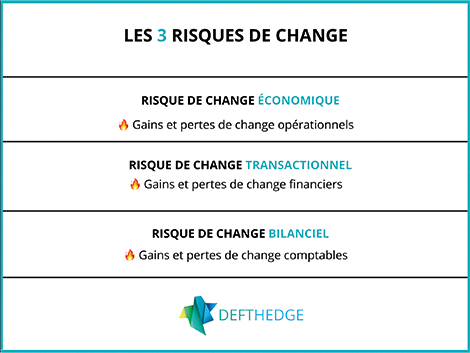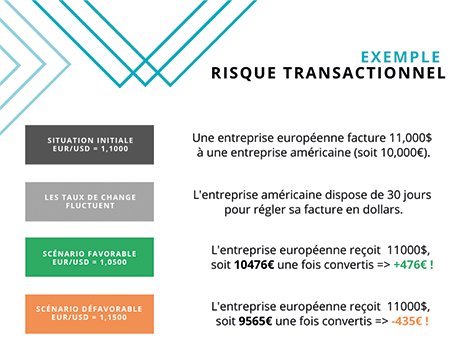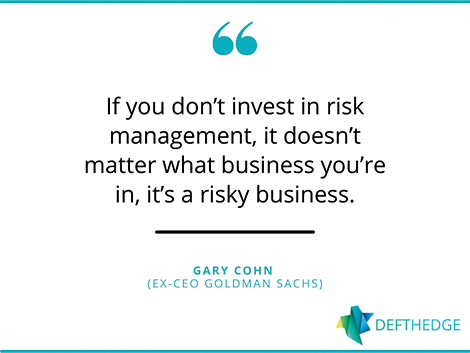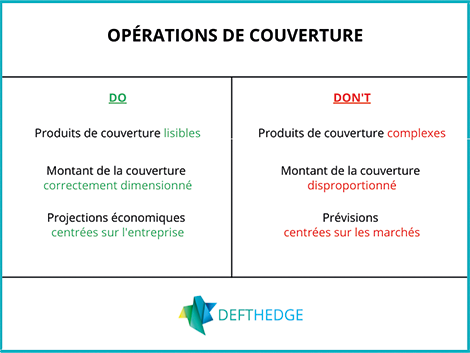Heavy financial losses, job cuts, bankruptcies… The consequences of poor foreign exchange risk management can be dramatic. So much so that the setbacks encountered by a few poor performers in this area would almost make us forget that good foreign exchange risk management is not just about avoiding the worst. Quite the contrary! In addition to neutralizing the risk, good foreign exchange risk management also aims to provide visibility and stability to the company. In a word, the conditions necessary for economic prosperity, job creation and innovation. How to manage your company’s foreign exchange risk? Where to start? What mistakes to avoid and what opportunities to seize? Here are the steps to follow to manage your company’s foreign exchange risk with professionalism in 2022.
#1 Understanding Foreign Exchange Risk
What is currency risk?
For a company, currency risk is the probability that changes in exchange rates on the foreign exchange market will have a negative impact on its business, income statement or balance sheet. It is one of the main financial risks to which companies are exposed, alongside interest rate risk, liquidity risk, credit risk and commodity price risk. The different exchange rate risks and their consequences.

Economic exchange risk
Economic exchange rate risk, also known as operational exchange rate risk, refers to the probability that a change in the exchange rate will lead to a change in the price structure of the market in which a company operates. For example, if a European exporting company with commercial outlets in the United States loses competitiveness due to a sharp appreciation of the euro against the US dollar, its euro-denominated goods will see their dollar prices rise as a result of the depreciation of the greenback, while those of its American competitors will remain unchanged. Loss of market share to local competitors, lower revenues and lower margins are all negative consequences that the company could experience in such a situation. Good to know: Unlike other currency risks, the economic currency risk cannot really be neutralized by the company beyond one fiscal year (in particular because of the difficulty of having sufficiently reliable commercial and economic projections over the long term).
Transactional currency risk
Transactional foreign exchange risk is the probability that a change in the exchange rate will result in an adverse change in the countervalue of an invoice denominated in a foreign currency. Once the company has issued the invoice in question, the transactional foreign exchange risk is the risk that the foreign currency will lose value against the euro. In such a situation, the value of the foreign currency invoice will remain the same, but its value in euros will decrease due to the exchange rate. Conversely, when the company has to pay the invoice in question, the transactional exchange rate risk will correspond to the risk of seeing the foreign currency appreciate against the single currency. In such a situation, the value of the invoice in foreign currency will remain the same, but its value in euro will increase due to the effect of the exchange rate.

Good to know: Transactional foreign exchange risk is the easiest for companies to hedge since it is simply a matter of locking in the exchange rate between the invoice issue date and the settlement date.
Balance sheet currency risk
Balance sheet currency risk is the probability that a change in exchange rates will result in an adverse change in a balance sheet item denominated in a foreign currency. In the event of a depreciation of the foreign currency, the balance sheet currency risk will result in a loss of value of the assets concerned (for example, the devaluation of an investment made in foreign currency). Conversely, in the event of an appreciation of the foreign currency, the balance sheet currency risk will result in an increase in the value of the liabilities concerned on the company’s liabilities side (for example, the valuation of a loan made in foreign currency). Good to know: Most of the time, assets and liabilities denominated in foreign currencies on the balance sheet can offset each other, so it is a matter of reasoning here on the company’s net exposure, and not on the sum of its exposures.
Why manage your company’s foreign exchange risk?
To protect your company
The first good reason to hedge against currency risk is to protect your company’s margins and profitability.

From the beginning of the production cycle to the sale (economic risk), then from the invoicing to the receipt of payment (transactional risk), the company runs the risk of seeing its expenses increase or its income decrease due to the effect of exchange rates. By implementing an appropriate exchange rate policy, and possibly opening hedging operations (financial operations allowing to lock in the exchange rates), the company is able to neutralize most of the risks: from a simple reduction in its margins to more serious economic consequences (liquidity incident, job cuts, bankruptcy…).
Gain visibility (and therefore performance!)
The second reason to hedge against currency risk is to gain visibility to enable your business to accelerate. By effectively managing currency risk, a company has better visibility into its margins and cash flows. It is therefore able to offer more aggressive pricing and launch new investment projects more quickly (opening a new subsidiary abroad, building an international team, service contracts, etc.).
Take care of your financial communication
Finally, the third good reason to hedge against currency risk is to communicate effectively with management, shareholders and/or creditors. Exchange rate fluctuations can lead to particularly impressive accounting exchange rate gains and losses, and such volatility can quickly worry a company’s various stakeholders, starting with those involved in its financing! In order to avoid strong volatility in their balance sheet and their main financial ratios (solvency ratios in particular), large companies sometimes choose to hedge their financial reporting, or at least to provide the necessary explanations to enable their shareholders and creditors to better understand these variations.
#2 Audit your company’s exposure to foreign exchange risk
Knowing your company’s exposure to foreign exchange risk is essential in order to adopt an appropriate foreign exchange risk management policy and strategy. Here are some examples of questions that need to be answered :
- How much of your sales are invoiced in foreign currencies?
- How much of your expenses are paid in foreign currencies?
- Do you have investments or debts in foreign currencies?
- Do you use hedging instruments?
- Are your margins sensitive to exchange rate fluctuations?
Because each company is unique, it is essential to perform a precise diagnosis of your risk exposure. During this step, you will be asked to prepare a precise budget forecast from which you will be able to simulate several scenarios and explore different hypotheses. >> Perform a self-diagnosis to evaluate your exposure to foreign exchange risk
#3 Define your company’s foreign exchange policy
Once you know your company’s exposure to foreign exchange risk, you can now define your foreign exchange policy with precision. – What level of risk are you willing to accept? – What resources are you willing to allocate to foreign exchange risk management? – What will your risk management objectives be? All of these questions are essential to provide a clear framework and direction for your foreign exchange risk management. These questions will help you determine the human, financial and technological resources needed to achieve your objectives, as well as the type of hedging you should use. Some companies will see their risk exposures offset themselves (natural hedging) and will only need to monitor the evolution of this situation over the years to detect any possible imbalance. Others, on the other hand, will have a net risk exposure that needs to be hedged, either on a yearly basis (macro hedging) or on a case-by-case basis (micro hedging). In the case of a macro-hedge, the company will have to define a budget rate for its fiscal year (the exchange rate at which it expects to convert its currencies), as well as a threshold rate (the acceptable limit exchange rate to be defended by its hedge). Good to know: It is also possible to choose between a static hedge (with a fixed amount) and a dynamic hedge (with a variable amount).
#4 Adjust your company’s business model
Before rushing headlong into the implementation of hedging operations, preliminary work can be done at the operational level to reduce your company’s exposure to foreign exchange risk and improve its natural hedging. Here are some examples of concrete actions:
- Reduce your production cycle time
- Reduce your invoice payment times
- Educate your sales teams on foreign exchange risk
- Relocate part of your production chain
Because setting up a currency hedge has a cost, these actions likely to reduce your hedging needs should be carefully considered to reduce your exposure to risk and make valuable savings.
#5 Successfully hedge your foreign exchange risk
Do not engage in speculation
Contrary to speculative operations whose objective is to bet in one way or another on the evolution of exchange rates, the purpose of currency hedging operations is not to increase your company’s exposure to risk, but rather to neutralize it. In order to do so, it is therefore necessary to give up predicting the future on the foreign exchange market. But that’s not all! In addition to its non-speculative character, a successful hedging operation is also and above all a correctly sized financial operation. And for good reason, exceeding hedging needs is tantamount to increasing exposure to risk instead of reducing it, with potentially dramatic consequences for the company…
Understanding the hedging products used
From simple forward contracts to more complex hedging products based on combinations of options, there are many products available to hedge your company’s foreign exchange risk. However, for most companies, the simplest hedging products will be the most suitable because they are easier to understand and much less expensive.

#6 Equip yourself with the right foreign exchange risk management tools
If the corporate treasurer is often presented to us as the modern-day MacGyver, capable of managing extremely complex situations with three bits of string and an Excel spreadsheet, times are gradually changing and his or her equipment is evolving for greater comfort and performance. Beyond the classic Excel spreadsheet, companies are now equipping themselves with financial forecasting and decision support software to modernize and simplify their foreign exchange risk management. From the identification of risk exposures to the monitoring of foreign exchange hedges, these solutions save precious time, eliminate human errors and allow companies to manage their foreign exchange policy with greater peace of mind.
Video solution : https://www.youtube.com/watch?v=kI7t0TRglUE

